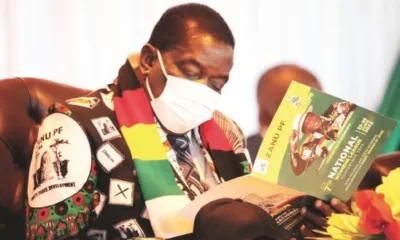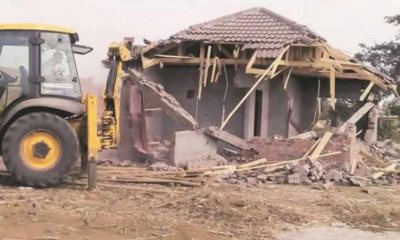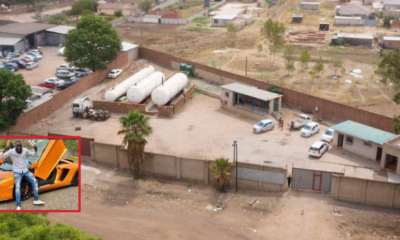
News
President’s wide powers on mining fuel extractive resources corruption
Published
4 years agoon
By
NewsHawks…President’s wide powers on mining fuel extractive resources corruption
THE excessive, wide and discretionary powers of the President of Zimbabwe and Minister of Mines over the country’s vast mineral resources and their allocation is perpetuating rampant corruption in the mining sector, an investigation commissioned by the Zimbabwe Anti-Corruption Commission (Zacc) says.
OWEN GARARE
Government says it wants to build a US$12 billion mining sector by 2023.
An investigative report, titled The Impact of Corruption on Zimbabwe Mining Sector, done by Albert Makochekanwa, a University of Zimbabwe economics professor, and submitted to Zacc last year, shows the sector is rotten to the core.
It says the extractives sector – buffeted by corruption, and environmental and sustainable development challenges – is far more corrupt than others.
The report was officially presented at a function held last November. Zacc is now under pressure to act on the critical study, which says vesting mineral resources control in the President and the Mines minister is perpetuating corruption.
It says the situation is worsened by the obsolete Mining Act (1964) that has too many gaps and weaknesses which allow corruption to thrive to a point where Zimbabwe is now practically facing a resource curse phenomenon instead of prosperity.
“Another major weakness of the Act is that it vests minerals endowments of Zimbabwe in the President and not the state, giving any incumbent president unlimited powers in decision relating to mining claim allocation and other related activities. This opens windows for corruption in the form of bribery and kickbacks,” the report says.
“Closely related to the above, the Act also gives the Minister of Mines excessive discretionary powers with limited accountability to his or her actions, thus making him or her vulnerable to corruption. The Act also says mining supersedes all land use, giving rise to conflict between miners and farmers. Given that, in most cases, miners are rich or politically connected people, the end result is that poor peasant farmers will be displaced from their land even without any meaningful compensation.”
The report further says the other big problem is political abuse of office by politically exposed persons.
“The involvement of politically exposed persons in the mining sector has perpetuated corruption. These people use their power to give or facilitate mining claims for their siblings, relatives and friends, and in most cases those who get such claims will not be having any capacity to mine, but they use the claims for speculating purposes or for renting out,” the report states.
“Such nepotism and favouritism have resulted in some owning lots of claims while those with capacity are left out. The fact that minerals are vested in the President (a political office), with powers to appoint a minister (responsible for mines), who in turn appoints the Mining Affairs Board makes the sector political. The board which is supposed to make critical mining-related decisions means that the independence of the board will be compromised by the appointment of these politically exposed persons.”
The report adds: “Those giving (mining claims) land use their discretionary powers to give people who give them bribe money, and this trend perpetuates corruption in the mining sector. As has already been discussed, conflicts between landowners e.g., farmers and miners with regards to land use has sometimes resulted in continued corruption as the one (between the two) with more money being able to bribe his or her way out”.
Zacc is under pressure to investigate the rampant corruption in the mining sector – which is mainly driven by political, bureaucratic and licensing system actors – from which billions of dollars have been siphoned.
The report details the nature and forms of corruption within the mining sector.
“The level of corruption in Zimbabwe’s mining sector is generally high when compared to other sectors in the country,” it says.
“Although corruption is found across majority of minerals, study respondents indicated that corruption is very high in the following three minerals (listed in order of corruption severity) (i) gold, (ii) diamond and (iii) chrome (ferrochrome). Platinum and black granite are other minerals that were said to have high level of corruption.”
Corruption in mining takes different forms, including bribery involving officials to get claims, extortion of minerals and foreign currency from artisanal small-scale miners, mining claims ownership disputes, under-declaration of resources, inflating of figures by contractors, licences to sell minerals, illegal selling of minerals to foreigners and outside Zimbabwe, abuse of office by Mines officials and politically exposed persons, and manipulation of institutional framework that seeks to combat corruption.
Government officials, including ministers, have repeatedly said Zimbabwe is losing US$100 million worth of gold every month through corruption and smuggling. Gold is the country’s biggest foreign currency earner.
In has been widely reported that billions of dollars have been looted and salted away from the diamond sector, especially the Marange alluvial mining concessions which caused global controversy, amid a previous storm over blood gems.
The late former president Robert Mugabe once claimed US$15 billion had been stolen from Marange, an assertion he later admitted to journalists was not substantiated with facts and figures.
Corruption runs deep in mining, the report further explains.
“Rampant corruption in Zimbabwe’s mining sector threatens to erode the potential the sector has to contribute towards economic recovery and drive socio-economic development in the country,” it says.
“Widespread corruption that has permeated the country’s mining sector brings to fore the resource curse phenomenon, where in the case of Zimbabwe, it is very difficult to point evidence of pro-poor developments that have solemnly been done using proceeds from the country’s mining activities over the years.
“Rather, evidence of the resource curse in Zimbabwe is depicted by widespread environmental degradation, pollution of water systems, loss of livelihoods, forced evictions and relocations, drug shortages at rural hospitals and clinics, dilapidated school infrastructure, collapsed bridges and poor road networks in areas where mining is taking place.
“Thus, instead of being a blessing to the general citizens, Zimbabwe’s mineral resources are increasingly turning out to be a resource curse. This is very unfortunate given that the expected ultimate goal for any mining company should be to leave a net positive benefit to the surrounding communities and the country in which it operates when mining is completed. Given this background, the study investigated the impacts of corruption in Zimbabwe’s mining sector.”
The study employed an integrated triangulation approach that allowed for collection and analysis of both qualitative and quantitative data and information.
That is, in conducting the research, the consultant – Makochekanwa — in collaboration with Zacc — collected data and information from diverse and randomly selected institutions and participants. The criterion for selecting the participants was based on their knowledge of activities in the country’s mining sector, directly or indirectly.
Two broad approaches were used: primary data and information gathering through field visits and interviews — with institutions and participants — where relevant information was collected through the use of a questionnaire.
Secondary data sources, including comprehensive desk review, were utilised. On field visits, the research systematically collected information from key informants who are knowledgeable about the mining sector.
The report says corruption in mining has done huge economic and societal damage in Zimbabwe.
“The impact of corruption shows that the biggest loser from this evil vice is the society at large as corruption causes unnecessary resource outflows and leakages, discourages honest entrepreneurship, encourages tenderpreneurers, and retards economic growth,” it says.
“In the case of Zimbabwe, all the major types of corruption are experienced and these include (i) grand corruption, (ii) political corruption, (iii) corporate corruption, (iv) bureaucratic/administrative corruption, (v) petty corruption and (vi) systemic corruption.”
The report also deals with factors perpetuating corruption.
“A number of factors have been enumerated as possible perpetuators of corruption in the mining sector,” it says.
Some of the factors include mining licences application.
“In the area of mining license application, a number of issues have contributed to the preservation of corruption. First, delays in processing and issuing of licences given that the unavailability of standard turnaround time has resulted in potential miners offering bribes to ‘speed the wheels’ of the processing wagon,” the report says.
“Second, the fact that the ultimate processing is centralised and done in the Ministry of Mines and Mining Development Headquarters (in Harare) has contributed to the temptation to offer bribes for one’s application dossier to be processed faster.
“Third, the manual processing, as opposed to computerised, of the mining application has meant that the whole application system is susceptible to manipulation. Fourth, unavailability of a mining cadastre and digital mining register gives powers to officials to adjudicate, thus prone to corruption and manipulation.
“Lastly, some mining prospectors bribe officials to jump the various queues and even have their papers backdated by various months or years so that they are construed to have been on queue for the longest time.”
The other problems include mining approvals.
“The system has, over the years, been accustomed to the fact that without bribing, one’s papers may take forever to be signed or approved,” it says.
“Mining regulations and statutes have also contributed their share towards sustenance of corruption in the sector. Double allocation of mining claims has not only been a breeding group for corruption in the sector for years, but has acted as a catalyst for perpetuating this evil.
“Double allocation has been a result of a number of factors including the following: Lack of a harmonised, foolproof and computerised mining allocation system has been a major factor in preserving corruption in this area of mining process chain.
“Lack of protection for corruption whistleblowers. The fact that there is no whistleblower protection when one reports corruption in the mining sector has been one of the many reasons why corruption has remained and continued to exist in this sector. As long as the corruption issue involves big politicians or elites, the whistleblower will be silenced by threats. Thus, lack of whistleblower protection is a contributing factor towards corruption as perpetrators continue without any fear or any possible deterrence.”
Then there is the obsolete Mining Act (1964) problem which has too many gaps and weaknesses.
“This Act unfortunately has many gaps and it is not commensurate with our modern societal and community expectations and aspirations. Furthermore, the Act makes no provisions for transparency and accountability in the sector, thus indirectly implying that those who can be corrupt can easily escape,” the report says.
“Another major weakness of the Act is that it vests mineral endowments of Zimbabwe in the President and not the state, giving any incumbent president unlimited powers in decision relating to mining claim allocation and other related activities. This opens windows for corruption in the form of bribery and kickbacks.”
The report also says there is a serious problem of flawed environmental and social impact assessment approvals.
“Environmental and social impact assessments are part and parcel of requirements for any sustainable mining activities in most societies. However, in the case of Zimbabwe’s mining sector, these assessments have sometimes been flawed due to a number of reasons,” it says.
The other complications include risk of insufficient community consultation and concealed identity of applicants.
“Secrecy in names behind some mining activities have been a catalyst for corruption in the sector,” the report says.
“Low transparency and the fact that no information is shared with the public with regards to the beneficiaries or owners of various mining companies has been a way of evading accountability and openness.
“For without transparency on who the applicants are and whether they meet the criteria, money can be used to twist allocations of rights, and without transparency there is no accountability.
“In Zimbabwe, lack of beneficial ownership clauses has been a loophole which has been exploited by politically exposed persons and government officials to use proxies and third parties to gain access to vast hectarage or acres of mineral resources. Some politically exposed persons and rich people have used different identities (or names) to get as many mining claims as possible.”
Secrecy in the sector is also problematic.
“Mining deals and contracts in Zimbabwe are done with uttermost secrecy to the extent that the citizens, who are the rightful owners of the country’s mineral endowments, are clueless of the various mining deals done with both local and foreign mining companies,” it says.
“The Non-Disclosure Agreements signed by government makes it impossible to scrutinise the contracts and compliance terms, thus making it difficult to hold both mining companies and government accountable. The continued process where there is limited or hiding of information has become a breeding ground for corruption as the citizens will not be privy to relevant and valuable information necessary for them to make follow-up and ask for accountability.
“The participation of politicians in mining sector, although it’s not a problem per se as it is their legitimate right as citizens of Zimbabwe to do so, the challenge comes in when they abuse their respective offices to corruptly influence mining activities.
“The involvement of politicians and political corruption has been one of the major channels through which corruption in the mining sector has continued to exist. The influence of politicians has been noted in different ways.
“First, trends in the country’s mining sector has shown that whenever there are discoveries of minerals, politicians do all they can to get the claims or they frustrate the owners till they vacate, fearing for their lives.
“Second, in some instances, awarding of mining claims and contracts has been facilitated mainly towards politically connected people, with other genuine bona fide and capable investors left in the cold.
“Third, tendencies by the ruling political party requesting mining entities to fund party projects, programmes and campaigns has been enumerated as one of the factors which have preserved corruption in the sector. Fourth, there have been instances where sometimes politicians have asked mining houses for off-the-book payments in the form of ‘facilitation’ or ‘protection’ fees.
“Facilitation whereby the politician will guarantee a given company quickening of any process the company may want, and protection whereby the politician assures the company that even if the latter breaks any mining regulation, the company will not be persecuted. Lastly, some politicians, even within the same political party, employ a policy of name dropping when they are either jealous of their colleague or they want to fix him or her. They corruptly pay the officials who man the mining registration books and claim that the political party wants person X to be dropped from the list.”
The report also says state-owned enterprises (SOE) in mining are corrupt as evidenced by the Auditor-General’s annual reports. The high and sustained level of corruption in parastatals has been due to a number of reasons including the following.
“First, if those who run SOEs (Executive and Board Members) are appointed on political grounds, they will just extend political corruption in SEOs activities. Majority of study participants claimed that there has been a lot of tokenism on appointment of management, weak autonomy and political meddling in decision making of the country’s parastatals,” it says.
“Second, over the years the government have been providing state (financial) subsidies to improve working capital and capital expenditure for some of the SOEs. Unfortunately, some of these subsidies have corruptly ended up in individual pockets.
“Third, lack of adherence to corporate governance is one of the reasons which have sustained and increased corruption in SEOs as they deal with mining sector. Fourth, the reporting mechanisms that some SOEs use are tailor made to ringfence and protect politically exposed persons politically appointed to run the affairs of the SOEs’ boards.”
Transfer pricing is yet another problem.
“Internationally, transfer pricing is most rampant in the mining sector than any other sector. This is due to, among others, the fact that mining companies tend to have branches and subsidiaries across different countries to satisfy their value chain, and Zimbabwe is not an exception.
“In the case of the country’s mining sector, transfer pricing has perpetrated corruption in a number of ways including the following two. First, there are cartels running mining activities in the country. Transfer pricing is the setting of the price for goods and services sold between controlled (or related) legal entities within an enterprise. For example, if a subsidiary company sells goods to a parent company, the cost of those goods paid by the parent to the subsidiary is the transfer price,” it says.
“These cartels are involved in externalisation of funds as well as shipping of locally generated money to various tax havens outside the country. All these activities are facilitated by brown envelopes given to officials who are found in various institutions.
“Second, there is currently no training which is provided in the area of curbing corruption especially to those who handle and deal with mining sector procedures. This corruption has been sustained even in cases where training could have reduced this immorality.”
Further, there is no transparency on ultimate beneficial ownership in most cases.
“Lack of transparency with respect to ownership of various companies involved in the mining sector has meant that even corrupt people are mine owners. There have been reports whereby individuals and businesses have been used as fronts, but with no power to prevent inappropriate business practices if the instigator of such practices is the real owner behind the scenes,” it says.
“Whilst the Companies Act has provisions around beneficial ownership, there is still lack of transparency and accountability on this issue when dealing with some mining companies.”




















